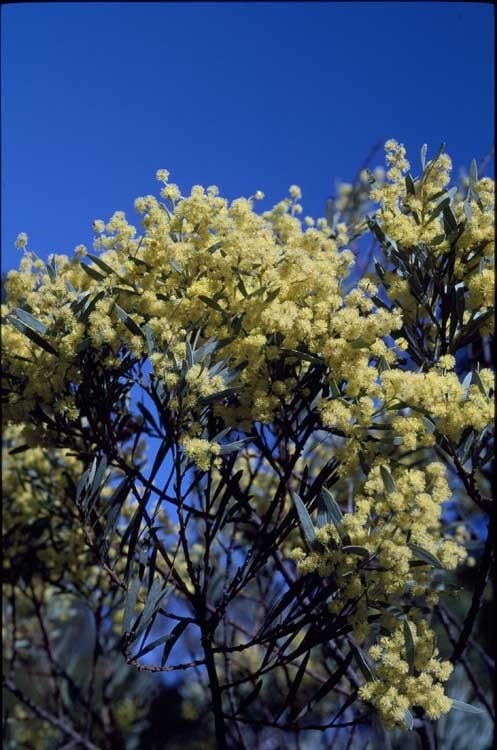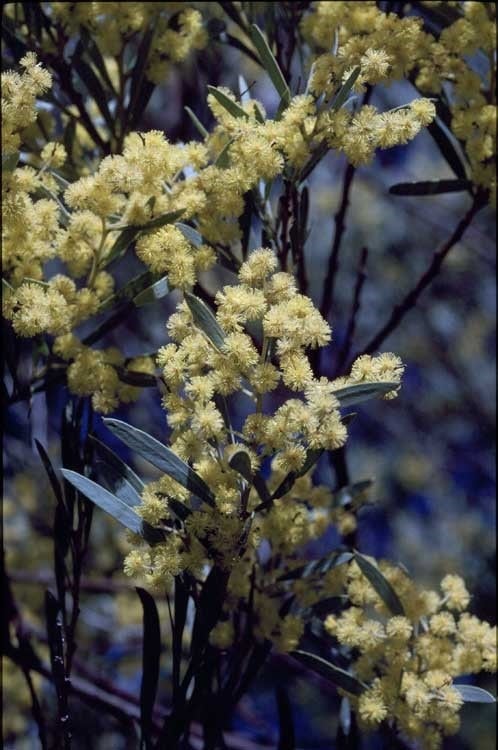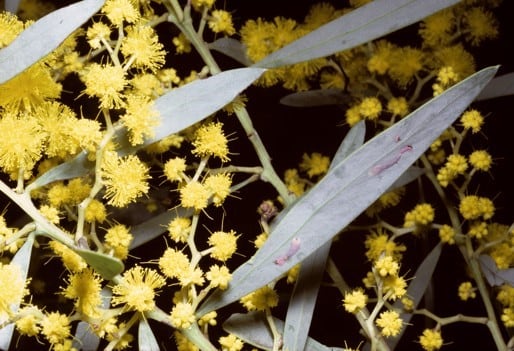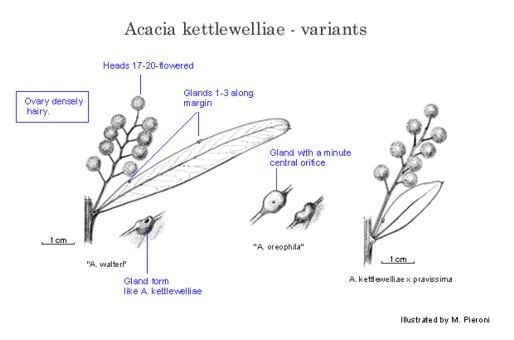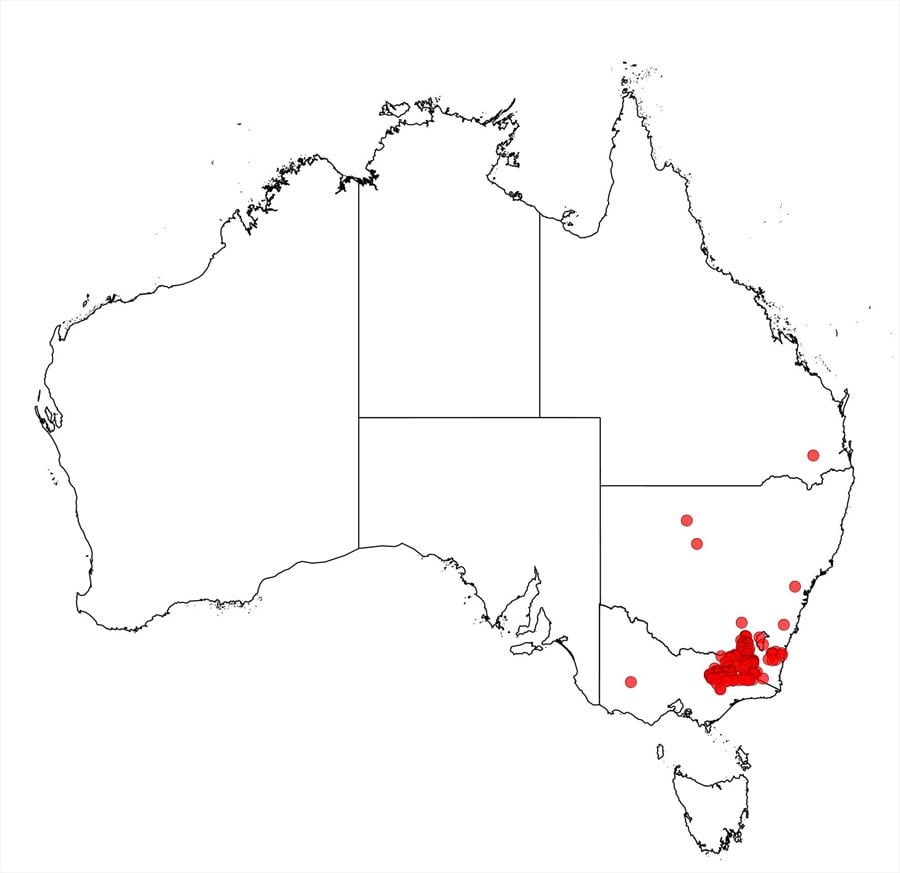Acacia kettlewelliae Maiden
WATTLE
Acacias of Australia
Common Name
Buffalo Wattle
Family
Fabaceae
Distribution
Occurs along the Great Divide from around Tumut, N.S.W., S to Mt Buffalo and near Omeo, Vic. A variant occurs in the Kybeyan Ra., N.S.W.
Description
Bushy shrub or tree usually 2–10 m high. Branchlets angled at extremities, glabrous. Phyllodes on raised stem-projections, narrowly (oblong-) elliptic to narrowly oblanceolate, usually 4–10 cm long and 4–10 mm wide with l:w = 8–13, mucronulate, thin, green to glaucous, glabrous except pulvinus normally sparsely hirtellous adaxially, 1-nerved per face; lateral nerves obscure; gland submerged and swollen within the lamina, with orifice at distal end of gland and usually downward-pointing, usually 5–15 mm above pulvinus. Inflorescences racemose, prolific in upper axils; raceme axes mostly 1–7 cm long, ±glabrous; peduncles 2–4 mm long, ±glabrous; heads globular, usually 8–11-flowered, bright light golden. Flowers 5-merous; sepals united to near their apices; ovary usually glabrous. Pods 5–10 cm long, 6–14 mm wide, firmly chartaceous, ±pruinose, glabrous, dehiscing unilaterally. Seeds normally longitudinal to oblique, oblong-elliptic to ovate, 4–5 mm long, ±dull, black; aril clavate.
Habitat
At high altitudes it grows in montane forest, but it also grows on lower slopes and near streams.
Specimens
N.S.W.: on the banks of the Tumbarumba Ck, 8.1 km from the main road junction in Tumbarumba and on the road to Tumut, N.Hall H79/101 (MEL, NSW, PERTH); Alpine Way, Kosciuszko Natl Park, J.Pickard & R.Coveny 2778 (NSW, PERTH). Vic.: Tambo R., c. 27.3 km E of Omeo, A.C.Beauglehole 41549 (MEL); Paradise Falls, 13 km SSE of Whitfield, B.R.Maslin 5946 (MEL, PERTH).
Notes
Hybrids with A. pravissima (see Fig. 29 I) occur at Paradise Falls, north-eastern Vic. (e.g. F.E.Bienvenu 0005, MEL). These hybrids resemble A. semibinervia. A putative hybrid, involving the same parents, is also known in cultivation from material collected from the Snowy R., N.S.W. (e.g. W.Molyneux s.n., PERTH01506293).
In Vic. and southern N.S.W. two forms can often be recognised in the field. In drier woodland sites it occurs as a shrub c. 2 m high, with short, narrow (to c. 5 mm wide), slaty grey-green to glaucous phyllodes; this form may resemble A. boormanii var. Mt Typo (F.E.Bienvenu 11). In wetter forests it occurs as a shrub or small tree to 10 m high, with long, broad (to 10 mm wide), olive green to sage dark green phyllodes.
The taxonomic status of A. oreophila and A. walteri requires further investigation; J.H.Willis, Victorian Naturalist 73: 157 (1957), regarded them as conspecific with A. kettlewelliae. The types are flowering specimens which differ from A. kettlewelliae in their densely hairy ovaries and more numerous flowers per head (i.e. 17–20; A. oreophila is erroneously given as 10–14-flowered in protologue). Also, in A. oreophila the gland is pustulate and exserted with a minute central orifice; in A. walteri there are 1–3 glands which, although somewhat similar to those of A. kettlewelliae, have a larger orifice which does not point downwards.
Acacia kettlewelliae appears to be most closely related to A. pataczekii and A. prominens.
Plants from the Kybeyan Ra., N.S.W., are unusual in being shrubs 1–2 m high with small phyllodes (1–3 cm long, 3–4.5 mm wide, l:w = 3–7, gland 1–6 mm above pulvinus), e.g. J.Pickard & R.Coveny 2822 (CANB, NSW, PERTH). These may represent a distinct taxon and there are indications that they hybridise with A. kybeanensis.
FOA Reference
Data derived from Flora of Australia Volumes 11A (2001), 11B (2001) and 12 (1998), products of ABRS, ©Commonwealth of Australia
Author
B.R.Maslin
Minor edits by J.Reid & J.Rogers
This identification key and fact sheets are available as a mobile application:
URL: https://apps.lucidcentral.org/wattle/
© Copyright 2018. All rights reserved.
